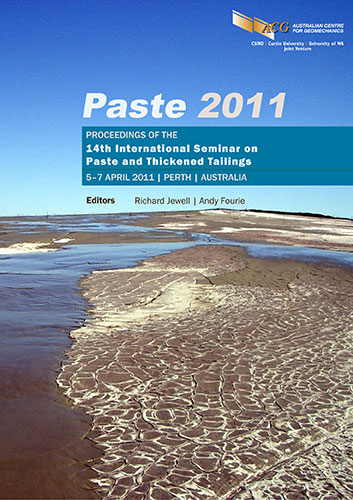Salitre Project – dewatered phosphate rocks tailings as alternatives to conventional tailings disposal, Vale Fertilizantes Minas Gerais State, Brazil

|
Authors: e Silva Marques , M; Lara, JL; Primeau, P; Palkovits, F; Kuyucak, N; Costa, LLAC |
DOI https://doi.org/10.36487/ACG_rep/1104_23_Marques
Cite As:
e Silva Marques , M, Lara, JL, Primeau, P, Palkovits, F, Kuyucak, N & Costa, LLAC 2011, 'Salitre Project – dewatered phosphate rocks tailings as alternatives to conventional tailings disposal, Vale Fertilizantes Minas Gerais State, Brazil', in R Jewell & AB Fourie (eds), Paste 2011: Proceedings of the 14th International Seminar on Paste and Thickened Tailings, Australian Centre for Geomechanics, Perth, pp. 245-260, https://doi.org/10.36487/ACG_rep/1104_23_Marques
Abstract:
Fosfertil Fertilizantes Fosfatados S.A., now Vale Fertilizantes (that represents Vale actives in the fertiliser operations) was contracted by Golder Associates Peru S.A. to conduct a trade-off study to assess the potential for a cost-effective long-term solution for tailings disposal. The focus of the study was based on identifying innovative dewatering/disposal techniques for the phosphate tailings for the green field Salitre Project. The study focused on a comparative evaluation of process dewatering options and disposal strategies relative to the currently planned conventional tailings disposal system. The evaluation included technical, operational, economical and environmental aspects of the Salitre Project. The main objective of tailing thickening process was to obtain high underflow density and, if possible, overflow clarity. The scope of work involved a laboratory testing program (material characterisation, process dewatering and rheological testing) and a concept level trade-off study examining a number of high-level strategies consisting of combinations of process dewatering options and disposal scenarios. Based on the material testing results, site conditions and input from Vale Fertilizantes it was recommended to dewater the Salitre tailings to achieve non-segregating thickened slurry having a solids concentration greater than 45 wt% solids. At this pulp density, the slurry behaves similar to high density tailings, albeit with significantly lower yield stress. The conceptual deposition plan utilises this rheology to develop a thin-layer disposal, relying on in situ desiccation to obtain even higher strength once deposited. Such an approach provides Vale Fertilizantes an opportunity to consider managing the tailings solids stream separately from the process water stream.
References:
Golder Associates (2010) Relatório Final: Fosfertil (Vale Fertilizantes) - Estudo da Alternativa Tecnológica Paste/Polpa Espessada Não-Segregável Aplicada a Rejeitos, May, Rev. 1, 58 p.
© Copyright 2025, Australian Centre for Geomechanics (ACG), The University of Western Australia. All rights reserved.
View copyright/legal information
Please direct any queries or error reports to repository-acg@uwa.edu.au
View copyright/legal information
Please direct any queries or error reports to repository-acg@uwa.edu.au